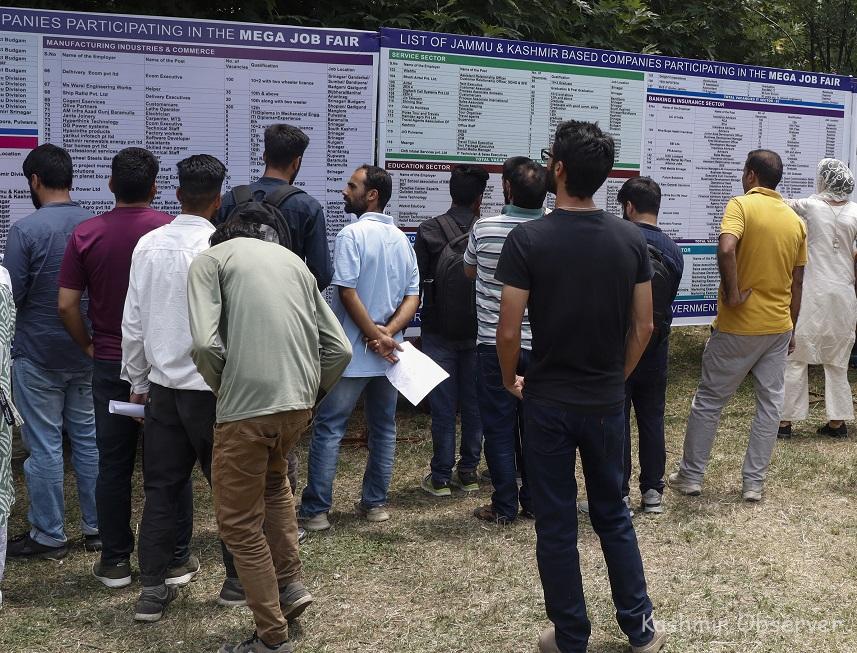Degrees Without Doors: Kashmir’s Youth at the Crossroads
By: Javid Amin | 28 October 2025
The Paradox of Education Without Opportunity
In the heart of the Kashmir Valley, a quiet crisis brews — one not marked by the sound of conflict, but by the silence of joblessness. The figures are staggering: as of September 2025, Jammu and Kashmir (J&K) has 3,61,146 educated unemployed youth registered with the Employment Department. Of these, more than 2.08 lakh belong to the Kashmir Division, and 1.52 lakh to the Jammu Division.
These aren’t unskilled laborers or dropouts; they are graduates, postgraduates, engineers, MBAs, and even PhDs — armed with degrees but denied dignified employment.
In a region where education has long been seen as a ladder out of uncertainty, thousands now find themselves trapped in what sociologists call the “aspiration-employment gap” — where qualifications rise but job opportunities don’t.
The Numbers Behind the Narrative
A deeper look at the district-wise data reveals structural imbalance:
- Anantnag leads the chart with 32,298 registered unemployed youth.
- Pulwama follows closely with 28,671, while Kathua and Srinagar register 26,798 and 23,826 respectively.
- Kulgam adds another 21,446, showing how the problem cuts across both urban and semi-rural geographies.
At the lower end, Kishtwar (8,870) and Reasi (12,376) show relatively smaller numbers — but analysts warn that this may reflect under-registration, not lower unemployment.
The gender divide adds another layer:
- Male unemployed: 2,33,845
- Female unemployed: 1,27,301
While more men seek formal work, women’s participation remains constrained by mobility, safety concerns, and limited professional options — particularly in rural Kashmir.
Education Explosion, Employment Implosion
Kashmir has witnessed a remarkable rise in higher education enrollment over the last two decades. Dozens of new colleges and universities — from South Kashmir to North Jammu — have produced an army of degree holders. But this “education boom” hasn’t translated into an employment boom.
As Dr. Shabir Ahmad, an economist at Kashmir University, puts it:
“We’ve created a system where degrees have become more symbolic than functional. Every family pushes children toward education, but the economy hasn’t expanded to absorb them. The result is frustration, overqualification, and migration.”
Public Sector: Shrinking Aspirations
For decades, the public sector was the dream destination for educated youth in J&K. Government jobs meant stability, social respect, and a secure pension. But that avenue has narrowed dramatically.
Post the 2019 reorganization of Jammu & Kashmir, bureaucratic restructuring and fiscal tightening reduced recruitment drives. The Public Service Commission (PSC) and Service Selection Board (SSB) exams became bottlenecks, with thousands of candidates competing for a handful of posts.
Even where vacancies exist, delays, litigation, and administrative red tape often freeze appointments for years.
“I completed my master’s in 2017 and applied for ten government jobs,” says Farhana, a 29-year-old from Ganderbal. “Each time the recruitment process either got cancelled or delayed. I’m still waiting.”
The Private Sector Puzzle
J&K’s private sector remains nascent and fragile. Unlike metropolitan economies, it lacks large-scale manufacturing, robust IT hubs, or industrial clusters.
The tourism, handicrafts, and horticulture sectors absorb a portion of semi-skilled workers but rarely offer professional growth for graduates. Meanwhile, security uncertainties and infrastructure gaps deter outside investment.
Even in emerging sectors like digital services, logistics, and renewable energy, local youth face stiff competition from better-connected mainland professionals.
“Private employers hesitate to set up offices here due to logistical risks and high insurance premiums,” explains an entrepreneur from Srinagar’s Rangreth IT Park. “Without private growth, public dependency continues.”
Skill Mismatch: The Employability Crisis
One of the most significant barriers is skill mismatch. According to the Periodic Labour Force Survey (PLFS), nearly 48% of J&K’s unemployed graduates lack job-ready skills.
Educational institutions often emphasize theory over application, leaving graduates unprepared for the demands of the digital or industrial economy.
A 2024 NITI Aayog assessment found that only 23% of engineering and management graduates from J&K meet national employability standards.
“We are producing degrees, not skills,” says education reformer and Mission YUVA mentor Nazir Lone. “Students learn outdated curricula. There’s little exposure to startups, technology, or industry internships.”
Mission Youth & Mission YUVA: Promise or Patchwork?
In response to this crisis, the J&K government launched Mission Youth and Mission YUVA, ambitious programs aimed at channeling the region’s human capital toward entrepreneurship, innovation, and self-reliance.
What They Promise:
- 4.25 lakh job opportunities (direct + indirect)
- 1.37 lakh entrepreneurship units
- Support for startups, women entrepreneurs, and skill development hubs
- Training through Tejaswini, Mumkin, and Rise Together schemes
The Reality Check:
While the vision is laudable, execution remains uneven. Beneficiaries report delays in disbursement, lack of mentoring, and limited market linkages.
A 2025 review by the Department of Employment noted that less than 40% of registered applicants under Mission Youth had received tangible benefits.
“We got the initial loan sanction, but no follow-up or incubation support,” says Zahid, a young entrepreneur from Pulwama who applied to start a local agritech venture.
The Entrepreneurship Illusion
The narrative of “be your own boss” resonates across government campaigns, but in Kashmir’s fragile economy, entrepreneurship faces unique hurdles:
- Access to credit: Many banks demand collateral youth entrepreneurs can’t provide.
- Market instability: Seasonal demand, limited logistics, and political uncertainty raise business risks.
- Mentorship void: There’s a lack of industry mentors and angel investors in the region.
Despite this, some success stories shine through. Initiatives like Kashmir Box, Raaya Foods, and eFruit Mandi demonstrate that local entrepreneurship can thrive with the right ecosystem.
Yet, these remain exceptions — not the norm.
Women on the Margins
Female graduates face compounded challenges — not just economic but cultural. Despite strong academic performance (women outperform men in several university results), their workforce participation rate hovers around 9–12%, among the lowest in India.
Social norms, limited mobility, and lack of women-friendly workplaces discourage participation.
“I want to work, but there’s no safe commuting option and my parents are hesitant about private jobs,” says Rukhsar, a postgraduate from Shopian.
Mission Youth’s Tejaswini program — meant to support female entrepreneurs — has improved awareness but struggles with outreach in conservative districts.
Migration: The Silent Exodus
With limited local opportunities, many young Kashmiris are migrating to Delhi, Bangalore, Pune, and Dubai for employment.
This migration — once seasonal or educational — is now becoming permanent. Skilled youth leave, draining the Valley of its best talent and weakening local innovation potential.
Sociologists call it the “brain drain paradox”: while the government invests in education, the returns are reaped elsewhere.
Mental Health & Social Fallout
The unemployment crisis isn’t just economic — it’s deeply psychological.
A 2023 study by the Institute of Mental Health and Neurosciences (IMHANS) found that 42% of unemployed youth in Kashmir report symptoms of depression or anxiety, driven by financial stress and social pressure.
“Parents feel ashamed when their educated children remain idle,” notes psychiatrist Dr. Arshad Rather. “It erodes self-worth, fuels drug use, and, in some cases, leads to radicalization.”
Youth idleness, when combined with political alienation, can also have security implications — a reality not lost on policymakers.
What Experts Recommend
Economists and educationists suggest a multi-pronged strategy:
- Curriculum-Industry Alignment: Introduce skill-based, tech-driven programs in universities.
- Incentivize Private Sector Growth: Offer tax relief and infrastructure support to local businesses.
- Strengthen Career Counseling: Expand Mission Youth’s district-level guidance cells.
- Digital Skill Push: Train youth in AI, coding, design, and e-commerce.
- Women-Centric Policies: Create flexible, remote job options for women graduates.
- Startup Ecosystem: Encourage incubators at universities and polytechnics.
“Kashmir’s youth are not lazy — they’re lost in a system that doesn’t connect talent with opportunity,” says sociopolitical analyst Suhail Baba.
The Way Forward: From Degrees to Directions
Jammu & Kashmir’s demographic dividend — its educated youth — can either become its greatest strength or its biggest liability.
The path forward requires both policy clarity and social empathy: ensuring that government programs deliver, private sectors are empowered, and education truly prepares youth for a modern economy.
Empowering youth is not just about jobs; it’s about restoring faith — faith that education still means something, that effort still counts, and that opportunity can still be earned.
Until then, thousands of young Kashmiris will continue to hold degrees that open no doors — waiting not for miracles, but for meaningful change.
Summary at a Glance
- Educated Unemployed (J&K): 3.61 lakh (Sept 2025)
- Top Districts: Anantnag, Pulwama, Kathua, Srinagar, Kulgam
- Government Initiatives: Mission Youth, YUVA, Tejaswini, Mumkin
- Key Challenges: Skill mismatch, weak private sector, bureaucratic delays
- Solutions: Skill alignment, private investment, digital job creation, women empowerment



